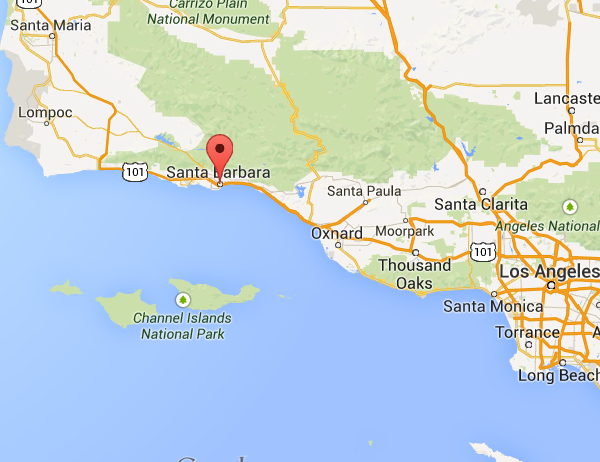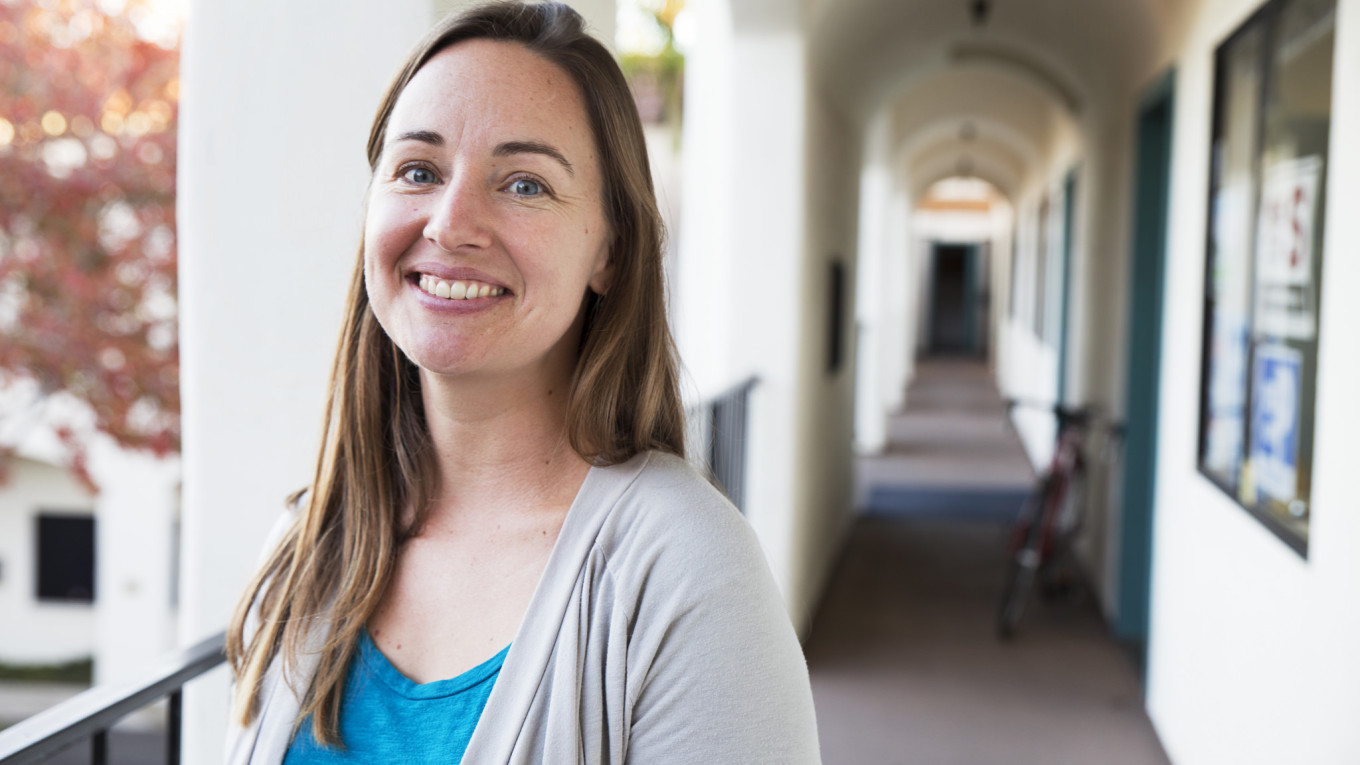
Rebecca Claassen
Story by Tara Lohan | Photography by Sarah Craig
A block from Rebecca Claassen’s home is a sliver of paradise. Mountains stoop nearly to the water’s edge. Lanky palm trees pitch gently in the breeze. Herons stand statue-still in the dunes. Rebecca has stolen a few moments with her daughter here at Carpinteria State Beach, 12 miles south of Santa Barbara.
Down time with family is a rarity for her in the last four months. Today, 3-year-old Hazel Claassen takes advantage, giggling as she tacks up and down the beach, stopping to inspect a dead bird, get a feel for a fistful of sand, and cart rocks from one pile to another.
Soon Rebecca will drop Hazel at day care and Rebecca will be on to the office. She’ll respond to a flood of emails, rally volunteers for weekend activities, and call residents to get the vote out for what has become an all-consuming cause: Measure P.
Measure P will appear on the ballot in California’s Santa Barbara County on November 4. And it seeks to ban “high-intensity” petroleum operations in unincorporated areas of the county. This includes the controversial practice of hydraulic fracturing (fracking) as well as acid well stimulation and steam injection.

The Santa Barbara Water Guardians, of which Rebecca is a leading member, filed to get Measure P on the ballot in mid-March. The group, along with 300 volunteers, gathered 20,000 signatures in 25 days to earn the measure a spot on the November 2014 ballot.
“We started making calls in July and have talked to nearly 20,000 voters and knocked on probably 20,000 doors,” Rebecca tells me over an orchestra of voices in the campaign office just a week before Election Day.
The issue is a big one in Santa Barbara County — especially for the oil industry, which has responded with checkbooks blazing to try to defeat the ballot measure. Less than a week before the election, Rebecca’s contingent of Yes on Measure P has raised $352,000, while No on P has tallied a whopping $5.8 million. Most of the opposition to Measure P has funneled through Californians for Energy Independence, which gets its money from oil companies, according to filings with the secretary of state’s office.
“I think they are pouring a lot of money in because a) they have big plans for our county,” Rebecca says. “And b) because they know that if we win it here, it will have a ripple effect and other communities will start to put their feet down.”
Environmental Concerns
In the last six months I’ve traveled across California, taking stock of the opposition that is mounting against oil and gas production methods that many communities are beginning to deem too risky.
Fracking — injecting water, sand, and chemicals at high pressure underground — has received the most public pushback. This has been true outside of California in states where fracking has enabled big booms in oil and gas, like Texas, Pennsylvania, Colorado, and West Virginia.
In California more than 3,000 wells have been fracked, the vast majority in Kern County, which leads the state in oil production and ranks second in agricultural production. At least one well was fracked in Santa Barbara County (and several more offshore), although the state has only required reporting the activity since the beginning of 2014 so other instances may be undocumented. So far, the yield hasn’t matched the economics of the effort, but that doesn’t mean it’s off the table completely — especially if the price of oil climbs high enough to warrant more intensive methods.
Californians are also focusing their sights on other industry techniques that increase production in hard to reach deposits of oil and gas.
“With fracking and cyclic steam injection and acidization, I realized we had a triple whammy of risks,” Rebecca says. “I decided to jump on in and start organizing. I felt inspired to take action based on thinking about what the planet needs, not just what we think is politically feasible.”
Rebecca is a chiropractor by trade but decided to put her career on hold when her daughter was one. “I realized how urgent the climate crisis is and that we have a real frontline issue here in Santa Barbara County with the Monterey Shale underneath our feet,” she says. The Monterey Shale is an underground rock formation underlying much of central and southern California that’s been estimated to hold anywhere from 600 million to 15 billion barrels of oil.
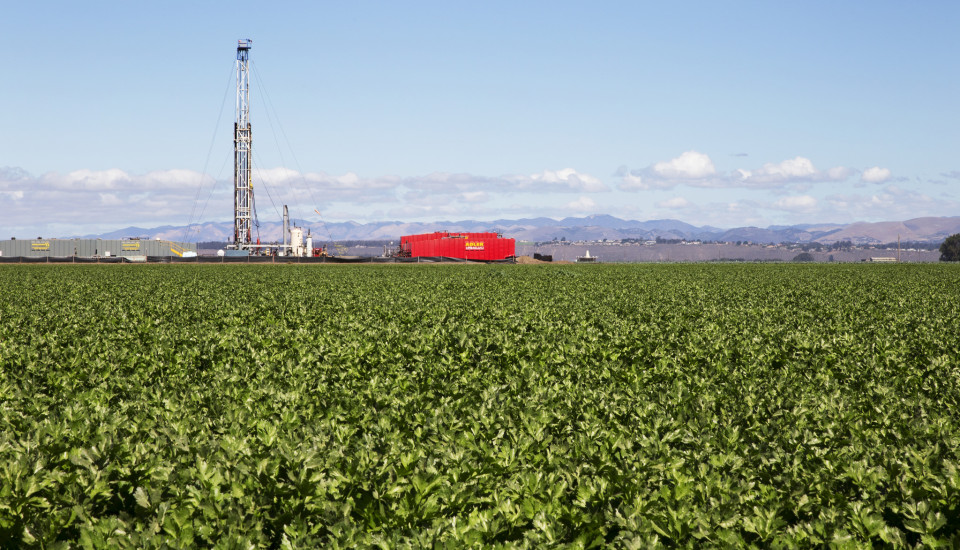
But she knows the Monterey Shale isn’t the only concern in her county. Most production recently here has focused on using steam injection to target not the Monterey Shale, which lies about 5,000 feet deep underground, but a layer of diatomaceous earth 1,000 feet below the surface. Diatoms are fossilized algae, their remains a bookmark from more than 4 million years ago.
The petroleum in this formation is so thick that conventional production methods can’t get it to the surface, so oil companies heat the water to 500 degrees (often by using natural gas) and then the steam is injected in the ground to liquify viscous deposits in the shale so it can be pumped out.
Steam injection is an energy and water intensive process. It produces roughly four times as much emissions as a conventional well. The Santa Barbara Independent reports that a recently approved 136-well project by Santa Maria Energy would cough up 88,000 metric tons of carbon dioxide every year — the same as adding 18,000 cars to the road. And the project would use several hundred thousand gallons of water a day.
Companies can use wastewater, but Dr. Catherine Gautier, a Santa Barbara-based climate scientist, says that if companies in the area ramp up production, they’ll need to use some potable water as a dilution. And even wastewater is becoming a hot commodity these days, with many industries beyond oil and gas reusing water in drought-plagued California.
Are we going to make energy choices that make the world better or are we going to make energy choices that make the world worse?
A lack of water isn’t the only concern with the process, though. Catherine says after the steam is injected, the petroleum that’s pumped out of the ground brings back with it other things that are in the shale layer, including heavy metals and radioactive materials.
“With cyclic steam injection, it’s not that they would be adding chemicals to the ground, it’s that within the tar formation there are toxins, and they are basically heating and steaming and releasing these chemicals,” explains Rebecca. “They are destabilizing a toxic formation that can meander and move wherever it wants in a highly cracked strata. It’s very worrisome.”
The wastewater produced from the process can be put into evaporation ponds, a lined sump where water is dumped and allowed to evaporate. If there are chemicals in the water this can contribute to air pollution or groundwater contamination if a pond’s lining tears. Or it gets disposed of underground in injection wells. “They protect the aquifer by cementing the bore hole,” Catherine says. “But cement is not perfect — it leaks. It could leak into an aquifer.”
Ballot or Bust
Just before their daughter was born, Rebecca and her husband moved back to Santa Barbara County from the San Francisco Bay Area. “I realized that my beloved Santa Barbara County was facing a huge transition to unconventional oil extraction,” says Rebecca, who grew up in northern Santa Barbara County. Her family lived mostly in Lompoc, but spent a couple of years living just south of Orcutt, where an existing oil field is still pumping.
“There was actually a poorly capped well underneath our house that caused both of our family dogs to die,” she says. “It was emitting toxic gases” that killed the animals. Her family signed a settlement with the responsible oil company, Rebecca says.
The legacy of oil production in the county dates back more than a hundred years, and the history hasn’t all been good. Residents still remember the 1969 oil spill off the coast of Santa Barbara that was the largest in California history and fouled beaches and killed wildlife. But it also birthed an environmental movement that continues to work to protect the region.
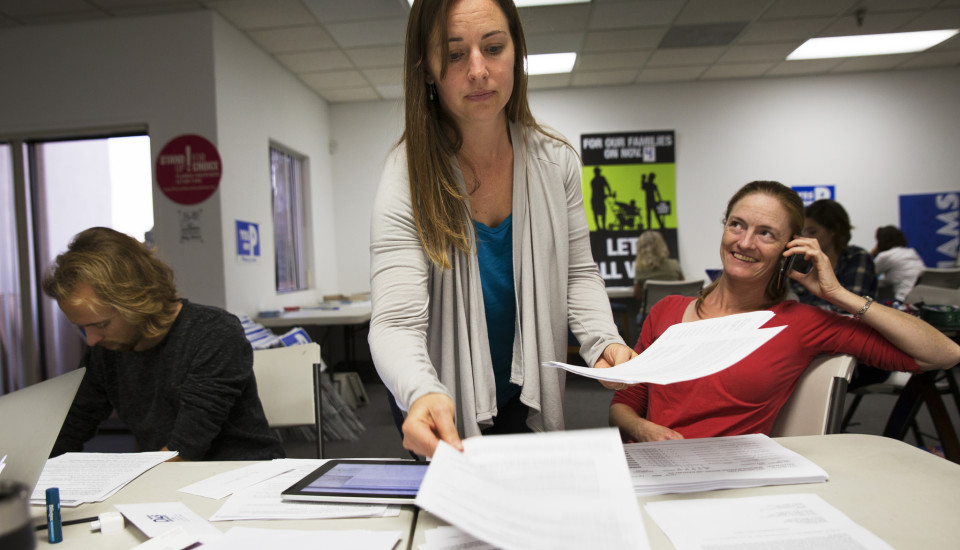
"Working for Yes on P" by Faces of Fracking, CC BY-NC-ND 4.0
This has helped spur action today. Rebecca says the catalyst for the ballot measure was when, despite much community opposition, the county’s board of supervisors last year approved Santa Maria Energy’s project for 136 cyclic steam injection wells. “The broader environmental community here in Santa Barbara felt like that was a floodgate opening,” says Rebecca. “As soon as that was passed, there would be thousands of new wells because the county wouldn’t have a precedent for denying them.”
Their concern proved warranted. The Santa Barbara Independent reported that following the approval, Pacific Coast Energy Company applied for 96 new wells, PetroRock LLC for 56 wells, ERGOperating for 233 wells, Aera Energy for 200-300, and if Santa Maria solidifies a big merger, they hope to drill as many as 7,000 new wells. The prime mode of production for these projects would be cyclic steaming.
Catherine, the Santa Barbara-based climate scientist, worries that if all these projects (and more in the future) are approved, it would require more infrastructure enabling the continued use of fossil fuels at a time when the world’s leading scientists say we should be trying to limit our carbon dioxide emissions.
“If we go ahead and produce oil, then we are going to burn it,” says Catherine. “And that means carbon dioxide emissions, and that means climate change. We cannot stop using fossil fuels totally, but we shouldn’t be investing in new infrastructure.”
To make matters worse, the oil that’s being produced here is a heavy crude that’s extremely carbon-intensive. “It’s hard anywhere on the West Coast to find something dirtier than the very viscous, hard-to-refine oil that they are extracting in parts of Santa Barbara County,” says Das Williams, the area’s state assemblyman. “It would be tragic to have communities that care about the environment so much, be tempted by this dirty of a source of energy.”
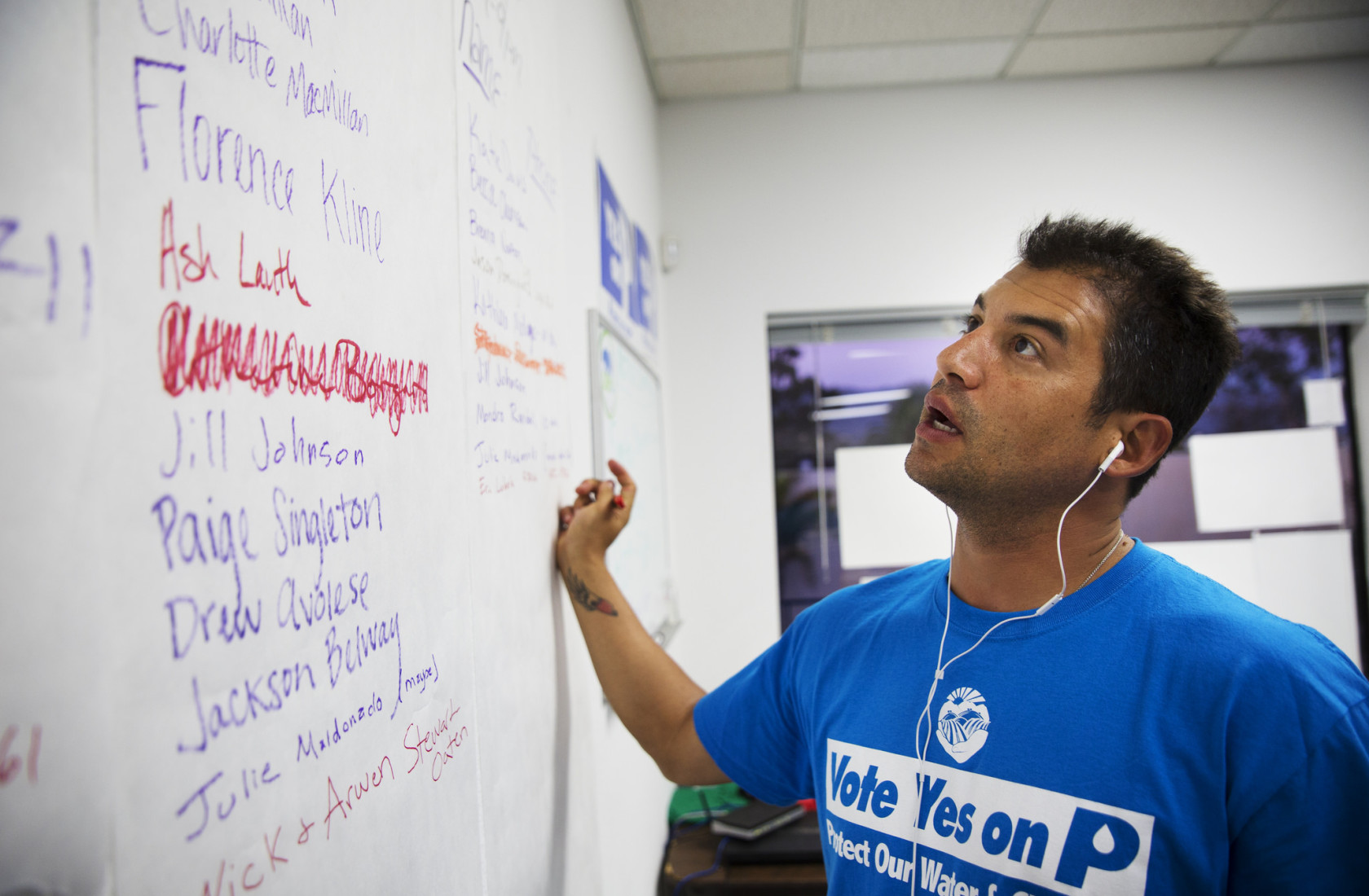
Das says he thinks Santa Barbara County faces a crucial choice right now.
“To me, there is a clear path we should be going down which is of cleaner energy, jobs that are in step with our values, energy choices that don’t make other people in other parts of the country or the world more miserable,” says Das. “To me it’s a question of what economic path, but it’s also a question about the soul of a community. Are we going to make energy choices that make the world better or are we going to make energy choices that make the world worse?”
A Path Forward
Sitting in the sand at Carpinteria State Beach, Rebecca’s daughter Hazel tells me that she’s seen a seal with its head bitten off by a shark. Nature has already left an impression on her. As she recounts the incident, seals emerge along the breaking waves. They swim north, keeping parallel to the beach, and are soon followed by a pod of dolphins, graceful fins slicing through the water. A surfer, paddling on his board, joins in.
Beyond them is the silhouette of Santa Cruz and Santa Rosa islands — part of the Channel Islands National Park. And sitting between the islands and the dolphins are seven offshore oil platforms.
Santa Barbara is a bit of an oxymoron like that. For a century both the oil industry and the integrity of natural environment have survived, although not without incident (like the ‘69 spill). But as oil production techniques increase in impact, residents may have to answer a tough question: Just because we can access the oil, does that mean we should?
For Rebecca, their fight is not just against intensive methods of producing fossil fuels, but for cleaner energy.
“I hope that we can lead in transitioning to renewables,” says Rebecca. “I really think that we can do that here in Santa Barbara County. We’ve got a ton of wind and sun and I really hope that my daughter witnesses a transformation right here. ”
This summer, Santa Barbara County green-lighted construction of a 40-megawatt solar facility that could provide electricity for more than 15,000 homes.

“I hope that my daughter gets to experience the same kind of natural beauty that I did growing up and that her air quality is good and that she can swim in the ocean without worrying about toxic fracking fluid being dumped from offshore oil rigs,” she adds.
Offshore fracking has been documented in state and federal waters, but there is little local residents can do. That’s why groups like the Water Guardians have focused on onshore activity with their ballot measure. Das Williams, the assemblyman, hopes it can help shake up the state’s capital where the oil industry has a lot of power.
“Until a ban passes in a county of significant size and significant oil development, then the logjam at the state level will not be broken,” he says.
Rebecca knows that given all the money flooding into the county from industry, her side has a tough fight. “Some thoughts that ran through my mind before starting this were things like ‘the oil companies might be the most powerful industry in the world.’ ‘It might have trillions and gazillions of dollars,’” she says. “But there is no way that any one industry can defeat 7 billion people on a planet that they love so much. We really can stand up together and put the industry in its place.”
Tell others about this
Faces of Fracking is a multimedia project telling the stories of people on the front lines of fracking in California.
